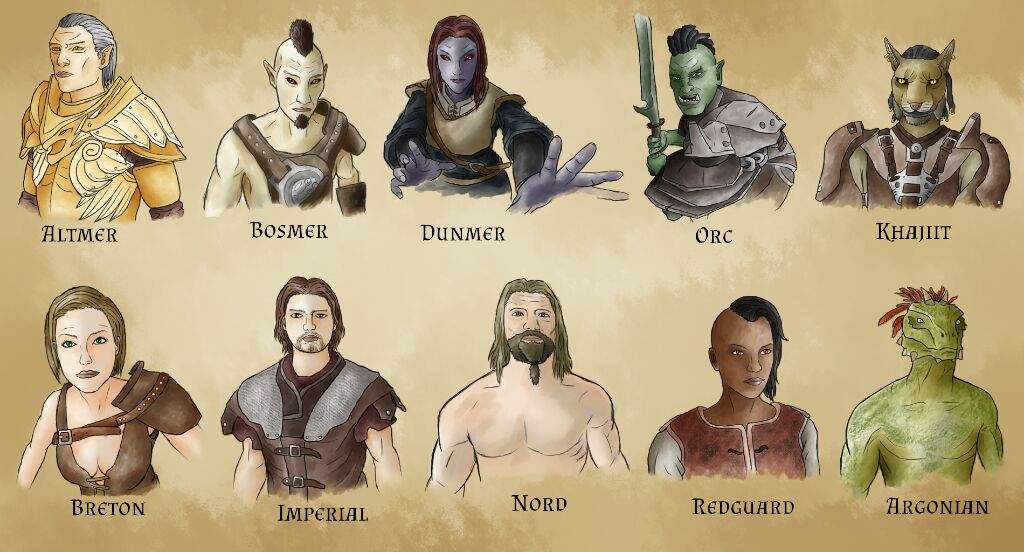The Peoples of Tamriel: Adaptation Notes

I’ve recently published a three-post miniseries adapting the humans, elves, and other interesting folks from the Elder Scrolls series of computer games to GURPS. Now I want to talk a bit about how I did it!
These three posts, and the One-Post Skyrim adaptation that preceded them, were the first time in a while where I was able to fully exercise the approach to adapting video games that I outlined as one of the very first articles on this blog. And the mini-series in particular was where I tried some new things, and I feel it’s worth talking about these things.
Researching the Source Material
Everything I said way back when in Adapting Videogames still reflects the way I think about this process. Fiction takes precedence over original mechanics, and I get to pick and choose from both in case they contradict themselves.
For One-Post Skyrim I had just the one game to look at, but for Peoples of Tamriel I needed to cast a wider net. Elder Scrolls is a sprawling, decade-spanning franchise, where these contradictions are bound to come up a lot more often. So how did I deal with it?
My “original sources” here were all the mainline games of the Elder Scrolls franchise, as described by the Unofficial Elder Scrolls Pages wiki1. That’s still a huge amount of data, and it’s positively filled with all those contradictions I mentioned above.
Most of them are mechanics-based. Basically, each game in the series differs as much from its predecessor as, say, D&D 3.0 is from AD&D, at a minimum. I decided to narrow the field down a little by looking at what changed and what remained constant between games. Things that changed every game were obviously less important to replicating its “feel” than things that stayed the same.
The big invariant here is the core gameplay loop: in every game, you wander and explore the world. You are given quests by NPCs, or discover them through other means. You enter dungeons, fight the enemies inside, and loot their treasure. There is a “main quest”, but you can choose to ignore it in favor of faffing about doing sidequests or simply raiding dungeons as you come across them.
You might remember I wrote pretty much the exact same thing during One-Post Skyrim. That’s because these things remain as true in Skyrim as they were in Arena2. All of it is very “high level” stuff, and does not require any specific tabletop mechanics to replicate, which is awesome for me. But how about the specific mechanical details? When it comes to playable character origins, the list of invariants is surprisingly small: you can choose from several. That’s it! The exact composition of the list and what each origin’s traits are changes significantly from game to game.
Adapting the Peoples of Tamriel
In the end I opted to use the list from Skyrim, which is both the most complete and the most popular of the franchise (it’s also used by Oblivion and Online). And when statting them up, I did two things: I avoided using the word “race” as much as possible, and I didn’t give them any attribute adjustments or mandatory mental disadvantages. This has the benefit of making these templates feel very “Skyrim”-like, since that’s also the way Skyrim does things. But there were other reasons why I chose this approach.
There’s an article out there that says it much better than I can, but unfortunately I’ve lost the link to it. Basically, the way racial attribute adjustment works in systems like D&D reinforces character stereotypes in a way that could be considered racist if it was applied to real-world people. Calling these bits of character creation races doesn’t help either, since that word has a lot of baggage from the real world.
GURPS Dungeon Fantasy doesn’t suffer from this to the same extent with attribute adjustments, since the cost of a racial template is small compared to the player’s total point budget. It does however, kinda fall prey to it when it comes to racial advantages and disadvantages. The bigot who says “all cat-folk are lazy spazzes”, or “all dwarves are hard-headed greedy bastards” ends up kinda having a point when those traits are a mandatory part of their templates.
I didn’t really want to play in a setting where bigots have a point, even about entirely fictional populations. I’m pretty satisfied with the final result: all the templates felt flavorful, and their traits didn’t force players to pick a particular profession over another as much. Players who want to hew closer to the cultural stereotypes about a given people could pick from the list of optional “Other Traits”, and could even pick optional traits listed under a different template for extra variety.
This worked out fairly well in my case because all the different people of Tamriel have roughly the same shape and size. GURPS is a system that places a lot of value on realism, so I imagine I would still need to keep some physical attribute adjutments in there if I were to include pixies and half-giants in the lineup. However, in systems or campaigns where that matters less even those wouldn’t need adjustments. I plan on keeping this approach with any other such templates I make.